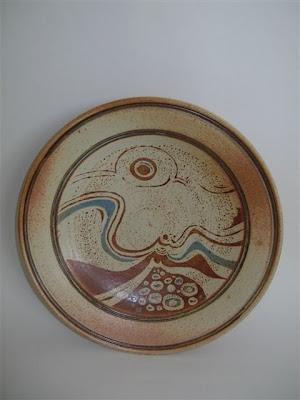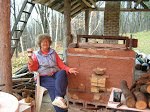In fact writing the blog has been really valuable for me - it helps me to focus on my work. By reading back from time to time I can see various stages in my progress. Another thing that it has done for me is to get me to take photographs of my pots - a really valuable record. As I look back over the old postings I can see various stages of my work - some good and some bad, but at least I can review them and learn from them.
So back to the Journey celebration weekend - unfortunately I did not take very many pictures - was too busy having fun!
Saturday morning we were treated to a short workshop on photographing pots. I must say this was the best talk on this subject that I have ever heard. Steven explained his setup to us, explaining where he got his equipment and how he used it. Not being a professional photographer himself, there was thankfully not a single mention of f-stops, etc - all the stuff that I can never understand no matter how hard I try.
He also took some pictures of our pots with his setup and in the evening we saw them on the computer - what a difference a great photograph can do to make a pot look great! I came home eager to get a something similar. Steven should really offer photography workshops as well - they would be well worth it.
In the afternoon the gallery was open and since Rob, Lindsay and Sarah lived in the area or had relatives living close by, there was a great turnout!
.jpg)
I really liked the lighted shelves that Steven had in his gallery - they really did a great job displaying the pots - as seen in this photo of my two fishing lady/boat pots.
Over a pizza supper we celebrated our accomplishments. Two art teachers/potters stayed for supper and it was very interesting to talk with them as they were involved with the Potters for Peace project - making water filters in Third World countries - something that has always interested me.
Sunday came way to fast - and it was time to say goodbye after a fabulous breakfast! Thank you Steven for a great journey! And thank you all, including Kim and Richard for making this such a great weekend! I hope that we can continue to follow each others' work and see how we develop.
This will be the last post under the Steven Hill Journey Workshop July 2008-09. However I am not giving up my blogging. I think I will continue this blog under a new name - Centered - Reflections on From and design or something like that - as I think writing down my thoughts about my pots will be a big help to me, even more so now that I do not have a monthly critique deadline.
However Steven offered us a chance to continue with the journey - either with another journey ending in a gathering in Oct 2010 or with just monthly consultations. Although I would love to go back next Oct, the airfare from Canada makes it rather expensive for me, so I will save that airfare for sometime in the future for another of Steven's workshops like the pouring vessel's and cups one.
However I am opting for the monthly consults which I hope to start after Xmas. I think that Steven will be able to help me define new goals for myself and those monthly critiques will keep me focused on those goals.























.jpg)
.jpg)
.jpg)
.jpg)
















.jpg)
.jpg)
.jpg)
.jpg)
.jpg)

